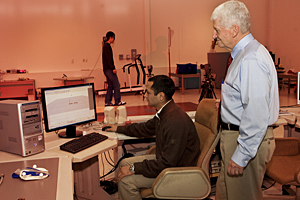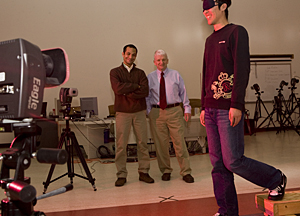
ADVERTISEMENT
- Rozovsky wins prestigious NSF Early Career Award
- UD students meet alumni, experience 'closing bell' at NYSE
- Newark Police seek assistance in identifying suspects in robbery
- Rivlin says bipartisan budget action, stronger budget rules key to reversing debt
- Stink bugs shouldn't pose problem until late summer
- Gao to honor Placido Domingo in Washington performance
- Adopt-A-Highway project keeps Lewes road clean
- WVUD's Radiothon fundraiser runs April 1-10
- W.D. Snodgrass Symposium to honor Pulitzer winner
- New guide helps cancer patients manage symptoms
- UD in the News, March 25, 2011
- For the Record, March 25, 2011
- Public opinion expert discusses world views of U.S. in Global Agenda series
- Congressional delegation, dean laud Center for Community Research and Service program
- Center for Political Communication sets symposium on politics, entertainment
- Students work to raise funds, awareness of domestic violence
- Equestrian team wins regional championship in Western riding
- Markell, Harker stress importance of agriculture to Delaware's economy
- Carol A. Ammon MBA Case Competition winners announced
- Prof presents blood-clotting studies at Gordon Research Conference
- Sexual Assault Awareness Month events, programs announced
- Stay connected with Sea Grant, CEOE e-newsletter
- A message to UD regarding the tragedy in Japan
- More News >>
- March 31-May 14: REP stages Neil Simon's 'The Good Doctor'
- April 2: Newark plans annual 'wine and dine'
- April 5: Expert perspective on U.S. health care
- April 5: Comedian Ace Guillen to visit Scrounge
- April 6, May 4: School of Nursing sponsors research lecture series
- April 6-May 4: Confucius Institute presents Chinese Film Series on Wednesdays
- April 6: IPCC's Pachauri to discuss sustainable development in DENIN Dialogue Series
- April 7: 'WVUDstock' radiothon concert announced
- April 8: English Language Institute presents 'Arts in Translation'
- April 9: Green and Healthy Living Expo planned at The Bob
- April 9: Center for Political Communication to host Onion editor
- April 10: Alumni Easter Egg-stravaganza planned
- April 11: CDS session to focus on visual assistive technologies
- April 12: T.J. Stiles to speak at UDLA annual dinner
- April 15, 16: Annual UD push lawnmower tune-up scheduled
- April 15, 16: Master Players series presents iMusic 4, China Magpie
- April 15, 16: Delaware Symphony, UD chorus to perform Mahler work
- April 18: Former NFL Coach Bill Cowher featured in UD Speaks
- April 21-24: Sesame Street Live brings Elmo and friends to The Bob
- April 30: Save the date for Ag Day 2011 at UD
- April 30: Symposium to consider 'Frontiers at the Chemistry-Biology Interface'
- April 30-May 1: Relay for Life set at Delaware Field House
- May 4: Delaware Membrane Protein Symposium announced
- May 5: Northwestern University's Leon Keer to deliver Kerr lecture
- May 7: Women's volleyball team to host second annual Spring Fling
- Through May 3: SPPA announces speakers for 10th annual lecture series
- Through May 4: Global Agenda sees U.S. through others' eyes; World Bank president to speak
- Through May 4: 'Research on Race, Ethnicity, Culture' topic of series
- Through May 9: Black American Studies announces lecture series
- Through May 11: 'Challenges in Jewish Culture' lecture series announced
- Through May 11: Area Studies research featured in speaker series
- Through June 5: 'Andy Warhol: Behind the Camera' on view in Old College Gallery
- Through July 15: 'Bodyscapes' on view at Mechanical Hall Gallery
- More What's Happening >>
- UD calendar >>
- Middle States evaluation team on campus April 5
- Phipps named HR Liaison of the Quarter
- Senior wins iPad for participating in assessment study
- April 19: Procurement Services schedules information sessions
- UD Bookstore announces spring break hours
- HealthyU Wellness Program encourages employees to 'Step into Spring'
- April 8-29: Faculty roundtable series considers student engagement
- GRE is changing; learn more at April 15 info session
- April 30: UD Evening with Blue Rocks set for employees
- Morris Library to be open 24/7 during final exams
- More Campus FYI >>
3:51 p.m., Nov. 18, 2009----The scenario seems as obvious as it is devastating: An elderly person stumbles on a step or trips on a curb and falls, and the impact of landing fractures a fragile hipbone.
Researchers at the University of Delaware, however, set out to see if the actual sequence of events in some of these injuries might be different.
“For our study, we posed a chicken-and-egg question,” said Mehmet Uygur, a doctoral student in UD's interdisciplinary Biomechanics and Movement Science Program, who earned his master's degree in biomechanics in 2008. “Which came first -- the fall or the fracture?”
The findings of the research team turned out to be groundbreaking, demonstrating for the first time that the force exerted on a bone by an elderly person's misstep is enough by itself to cause a fracture, Uygur said. That injury would, of course, almost immediately result in a fall.
“The results were very significant,” said David Barlow, associate professor of health, nutrition and exercise sciences, who was Uygur's adviser for his master's thesis and a member of the research team. “We found that the forces that occur in a misstep are astoundingly high, as much as eight times the person's body weight. That's so high that it seems likely that a misstep that causes a fracture is something that happens quite often.”
More research will be needed to learn how frequently that scenario occurs, Barlow said, “but now we've demonstrated that it can happen, so there's a lot of interest in these findings.”
The research was published in the June issue of the Journal of Biomechanics, with Uygur as the lead author, marking the first time a UD graduate student was published in that prestigious journal, according to Jim Richards, Distinguished Professor of Health, Nutrition and Exercise Sciences. Uygur also won a “best presentation” award at the annual biomechanics symposium held in May at the University's Center for Biomedical Engineering Research.
Other members of the research team and co-authors of the journal article, in addition to Uygur, Richards and Barlow, were Slobodan Jaric, professor of health, nutrition and exercise sciences, and then-graduate student Paulo B. de Freitas, who has since completed his doctorate.
To conduct the research, Uygur constructed a 7-inch-high box -- the height of a standard stair step -- and placed it on top of a force plate in the floor of UD's high-tech Human Performance Lab. The height of the box was level with an adjacent platform on which the research participants could walk for a few strides. All the participants were young, healthy adults who were uninjured during any of the experiments, Uygur noted.
Each participant took part in four different activities: walking along the platform and stepping onto the box; walking along the platform and stepping down, where the box had been removed; and doing each of those activities while blindfolded. In the situation where a blindfolded participant stepped down, he or she was not aware that the box had been taken away. Uygur said that situation provided the key to measuring the force that occurs when someone missteps.
“When you know that you're going to be stepping down, your ankle flexes so that you land on your toes, and your knee flexes slightly also,” Uygur said. “That dissipates a lot of force. But if you don't realize that you're stepping down, your heel hits first [as if you were walking on a level surface] and your leg is stiff, and that misstep applies a lot of force to your bones, especially the joint in your hip.”
While the force plate in the floor measured the impact of the research participants' steps, they also were tracked by Human Performance Lab cameras that translated their motions into a three-dimensional image on a nearby computer screen. With the variety of data gathered, the researchers were able to calculate the force that normal stepping and misstepping exerted on the participants' bones.
Previous research has determined how much force is needed to cause bone fractures in an elderly person, and Uygur said the team's calculations found that more than enough force occurred in missteps.
“Misstepping is a common occurrence at any age but especially in the elderly,” Barlow said. “If this research can be used to prevent fractures, that's extremely important. Twenty percent of the elderly people who sustain hip fractures pass away within the next year.”
Uygur said he also hopes the research can eventually be used for prevention, perhaps by modifying elderly residents' homes to eliminate changes in elevation, by making steps lower than their current standard height or by designing a shoe that could reduce the impact from a misstep. “I don't know where this will go, but I think we've opened up a lot of possibilities,” he said.
Article by Ann Manser
Photos by Ambre Alexander



